 One of the first and endless lessons of spiritual community is to find one’s way somehow—perhaps brilliantly and with friendship, perhaps awkwardly or scarcely at all—with those who, like you, have arrived from points unknown and show no sign of going elsewhere. People of different kinds seek the same light. Unlike in temperament, background, and experience, in gifts and blanks, in willingness and fears, they reach one and the same destination: a spiritual community that called from the distance and drew them in. Whatever the focus may be—a traditional faith, a teaching or way of life—it makes urgent sense to those who respond. They may know a great deal about the community’s concerns but are unlikely to know many of those whom they will meet and with whom they may associate for years, even a lifetime.
One of the first and endless lessons of spiritual community is to find one’s way somehow—perhaps brilliantly and with friendship, perhaps awkwardly or scarcely at all—with those who, like you, have arrived from points unknown and show no sign of going elsewhere. People of different kinds seek the same light. Unlike in temperament, background, and experience, in gifts and blanks, in willingness and fears, they reach one and the same destination: a spiritual community that called from the distance and drew them in. Whatever the focus may be—a traditional faith, a teaching or way of life—it makes urgent sense to those who respond. They may know a great deal about the community’s concerns but are unlikely to know many of those whom they will meet and with whom they may associate for years, even a lifetime.
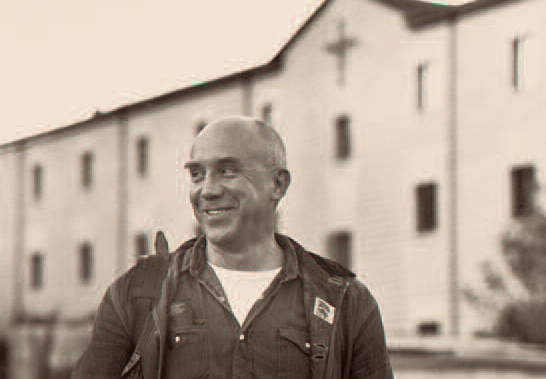
Photo by John Lyons.Used with permission of the Merton Legacy Trust and the Thomas Merton Center at Bellarmine University
There is a second endless lesson: one must find one’s way with the local human population because of a loyalty to the teaching or faith that surpasses other concerns without exception. Many dramas ensue from these two premises: loyalty to the teaching, human differences. The loyalty pins you in place. The differences, when serious and seemingly without remedy, fling you apart. “Make peace before the sun goes down” is a potent injunction in the sixth-century Rule of St. Benedict, which to this day governs Cistercian communities. The words are from Paul’s Letter to the Ephesians; their authority and challenge are ageless.
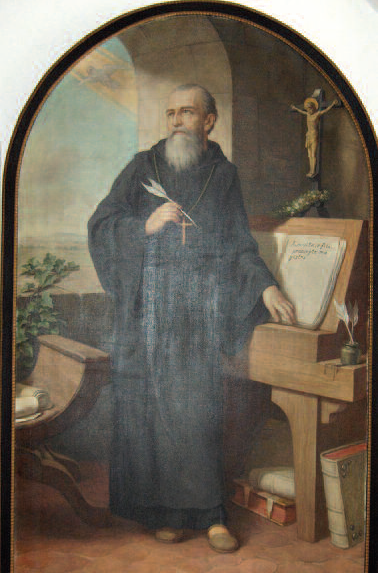
Herman Nieg, 192
As he matured in the monastic life, Thomas Merton became a Cistercian through and through. He was “the next chapter”—our chapter—in the luminous spiritual and intellectual life rooted in the example and writings of St. Bernard of Clairvaux and the generations surrounding him. James Fox, abbot of Gethsemani from 1948 to his retirement in 1967, was by temperament and conviction a Trappist. There should be no great difference between these two callings; after all, Dom James would typically close letters with the promise that his correspondents would be remembered “in the daily round of our Trappist-Cistercian life of prayer and sacrifice here at Gethsemani.” Notre Dame de La Trappe is the monastery in Normandy renewed in practice and rigor by its famed seventeenth-century abbot, Armand-Jean le Bouthillier de Rancé. It was a new edition of Cistercian life, rescued from the laxity, financial exploitation, and adversities of prior centuries. But it was a new edition with a difference. “As monastic life is but a school of penitence, humility, and abjection, nothing suits it better than humiliations,” wrote Rancé. “Religious congregations are collections of criminals and public penitents who, lacking the fidelity they owed God, and having irritated him by their disobedience, can no longer aspire to receive any goodness from him until they have satisfied his justice through punishments worthy of their sins…. The cloister is a prison….” The words are from a nearly one-hundred page exposition—surely the longest of its kind in Christian or any other literature—on the central importance of deliberate humiliation and mortification in the monastic life. Rancé was by no means only a prison warden; he possessed charm, generosity, worldly sophistication, a sure way with words. In his lifetime La Trappe was a magnet for serious religious. But he was also a prison warden.
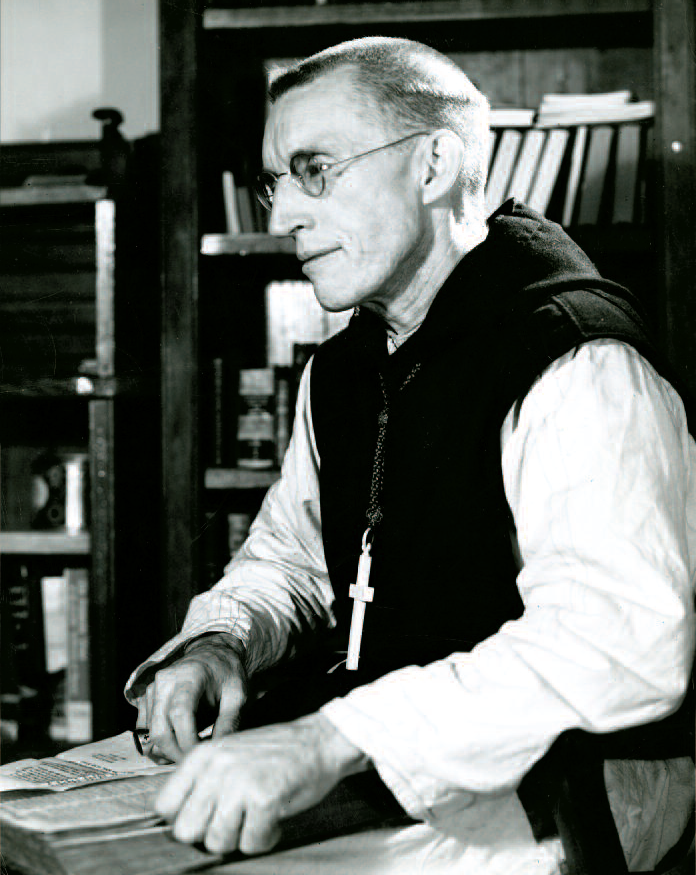
By the mid-twentieth century the distinction between Cistercian and Trappist was a shade of difference, a wrinkle in a continuous fabric. Dom James was, of course, a Cistercian who cared very much about sustaining a cheerful and cheerfully resolute spirit in the community. But in certain respects—his personal spirituality and the severity of restrictions imposed on Merton—he nonetheless recalls Rancé. On his side, Merton was not a permanently sunny soul. He lived in a state of inquiry, a kind of uneasy joy; he suffered periods of personal agony; and he valued the moderate austerities of monastic life, which for the most part he found natural and helpful. Yet his mature spirituality recalls the warmth, breadth, and depth of the Early Christian desert fathers and the first Cistercian generations. “Are you saying,” I questioned Fr John Eudes Bamberger, a man ancient and wise who knew them both well, “that, in writing about Thomas Merton and Dom James, nuance is needed everywhere?” “Amen!” he replied.
Even when harshest, the long encounter between Thomas Merton and Dom James can and should be understood—partially, with nuance—in light of a truth recorded somewhere in the writings of St. John of the Cross: “If you are going to be a saint, the brothers must make you one.” Merton’s spiritual and intellectual scope, and his restless nature ever seeking more light and depth of experience, confronted Dom James with a brilliant alien, a creature unlike himself though identically committed to monastic life. To some unquantifiable degree the abbot learned from the encounter, shared with ease some aspects of community life, and toward the end of their association took his lead from Merton in an important respect. On Merton’s side, the abbot’s restrictions generated immense discomfort but plunged him into sustained reflection about the nature of monastic life in the modern era, the scope and demands of his vocations as a contemplative and author, the struggle for willing obedience and intelligent self-sacrifice, and much else—themes memorably explored in his journal and in correspondence with trusted others. His legacy would be much the poorer, had he not encountered Dom James. Up to a point, they were each other’s soul-maker. I don’t know whether they made one another saints; there can be no doubt that they added to one another’s resourcefulness and understanding of life.
Out of a chrysalis
“What on earth am I doing here?” Merton asked himself in a journal entry, mid-November 1957.
I have answered it a million times. “I belong here” and that is no answer. In the end, there is no answer like that. Any vocation is a mystery and juggling with words does not make it any clearer.
It is a contradiction and must remain a contradiction.
I think the only hope for me is to pile contradiction upon contradiction and push myself into the middle of all contradictions.
Thus it will always remain morally impossible for me simply to “conform” and to settle down and accept the official rationalization of what is going on here. On the other hand it in no way helps matters for me to replace the official statements with slightly better rationalizations of my own…. If you want to find satisfactory formulas you had better deal with things that can be fitted into a formula. The vocation to seek God is not one of them. Nor is existence. Nor is the spirit of man.
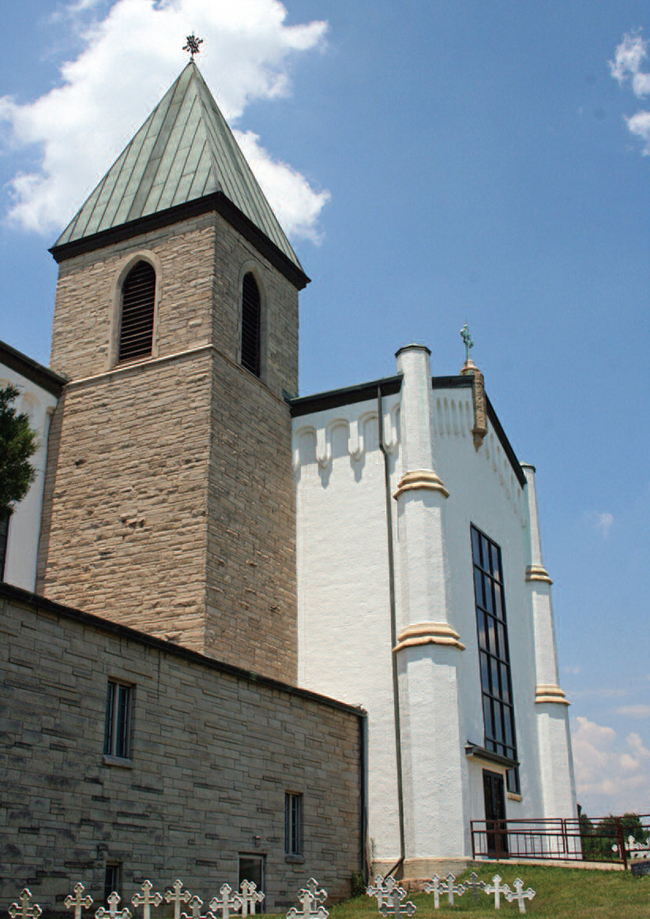
The nested sequence here—vocation, existence, the spirit of man—points toward the widening and deepening awareness of his maturity. I don’t know exactly when the ascetic stripling in early photographs of Merton at Gethsemani became the full-bodied man encountered in photographs of the 1960s. At some point he began to look something like a longshoreman and something like the writers Henry Miller and Jean Genet. Miller thought he looked like Picasso, and Merton thought of himself that he looked like Picasso, Genet, or “a Barcelona hotel keeper.” Where the writers and artist are concerned, if not the hotelier, he had in common with them qualities evident in their faces of vitality, complexity, and recognition of the human tragicomedy in which they knew themselves to be implicated. Merton did indeed “push himself into the middle of all contradictions” and make his home there. That transformation occurred in these years. In the spring of 1958, he noted in his journal: “Thinking of the new and necessary struggle in my interior life. I am finally coming out of a chrysalis. The years behind me seem strangely inert and negative, but I suppose that passivity was necessary. Now the pain and struggle of fighting my way out into something new and much bigger.”
Early in 1958, Merton was inwardly in motion. “I am obscurely convinced,” he noted in his journal, “that there is a need in the world for something I can provide, and that there is a need for me to provide it. True, someone else can do it, God does not need me. But I feel He is asking me to provide it.” This is both a declaration of independence and an acknowledgment of interdependence—of a world to which he is bound, though by a still somewhat unclear duty. He was speaking with Dom James from time to time about a South American foundation and longing to be part of any such venture. James put him off—the moment hadn’t come to think seriously about the project, though an offer of land had been received from a wealthy Colombian. We could “grow corn and frijoles,” Merton speculated. There was ever a child in him.
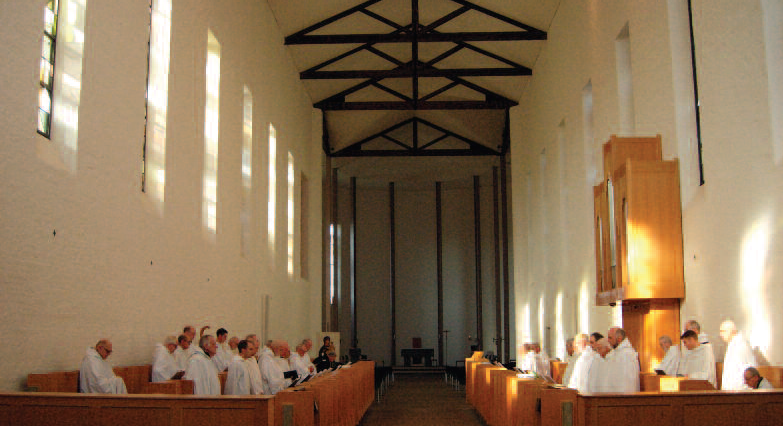
We are now on famous ground. Everyone who cares for Merton’s life and writings is likely to remember something of his dream about a young Jewish girl who gave her name as Proverb, and likely to remember in detail his spontaneous visionary experience at “4th and Walnut” in Louisville. Proverb appeared to him one night at the end of February. “I am embraced with determined and virginal passion by a young Jewish girl,” he recorded in his journal. “She clings to me and will not let go, and I get to like the idea…. I reflect ‘She belongs to the same race as St. Anne.’ I ask her name and she says her name is Proverb…. No need to explain. It was a charming dream.” A charming dream, easily dismissed—but almost at once Merton felt drawn to write a letter and within a few days drafted it into his journal. “Dear Proverb,” he demurely began what must be his first love letter since entering the monastery in 1941,
How grateful I am to you for loving in me something which I thought I had entirely lost, and someone who, I thought, I had long ago ceased to be. And in you, dear, though some might be tempted to say you do not even exist, there is a reality as real and as wonderful and as precious as life itself. I must be careful what I say, for words cannot explain my love for you…. I think what I most want to say is that I treasure, in you, the revelation of your virginal solitude … yet you have given your love to me, why I cannot imagine.
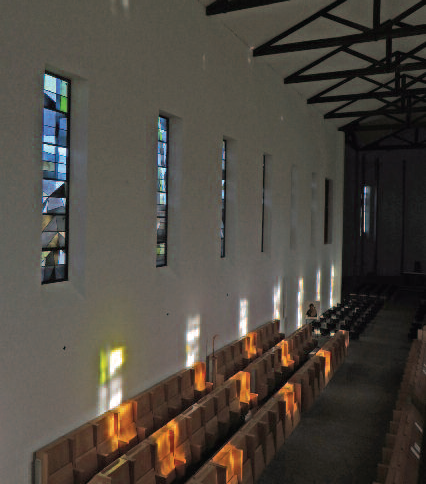
An excerpt from the letter may make it seem syrupy; it is anything but. It is an acute recognition of emotional and sexual energies within Merton which, in the uncanny play of character and Providence, now declared themselves and hereafter might move aside but never disappear. Instinctively making her as real as possible, Merton wrote in the here and now to a girl irretrievably there and elsewhere.
His encounter with Proverb in late February-early March was renewed in the incident at 4th and Walnut two weeks later. Here again, famous ground. “Yesterday, in Louisville, at the corner of 4th and Walnut, suddenly realized that I love all the people and that none of them were, or, could be totally alien to me. As if waking from a dream—the dream of my separateness, of the ‘special’ vocation to be different…. Thank God! Thank God! I am only another member of the human race, like all the rest of them. I have the immense joy of being a man!” And he concluded the entry with a second letter to Proverb, as if they had met at 4th and Walnut. “Only with you are these things found, dear child sent to me by God!” In a letter to the novelist Boris Pasternak later in the year he was clearer still: “I was walking alone in the crowded street and suddenly saw that everybody was Proverb and that in all of them shone her extraordinary beauty and purity and shyness, even though they did not know who they were.”
Toward the end of the year Merton was able to articulate his new insights and feelings at a moment when he was looking back over his published poetry in a measured but critical frame of mind. He could see the good in what he had written, yet he had become a different person, as fervent as ever but in a wholly new way. “The new fervor will be rooted not in asceticism but in humanism,” he wrote in his journal.
What has begun now must grow but must never seek to become spectacular or to attract attention to itself—which is what I unconsciously did in those days, proclaiming that I was a poet and a mystic. Both are probably true, but not deep enough, because then it was too conscious. I have to write and speak not as the individual who has cut himself off from the world and wants the world to know it, but as the person who has lost himself in the service of the vast wisdom of God’s plan to reveal Himself in the world and in man. How much greater, deeper, nobler, truer and more hidden. A mysticism that no longer appears, transcendent and ordinary.
From Proverb by night and the streets of Louisville by day to his new sense of purpose there is little distance; those encounters gave rise to it.
As this is Merton, there was an intellectual element at work in his passage out of the chrysalis and into the middle of all contradictions. He was reading widely—perhaps for the first time in nearly two decades about social and ideological forces—when he found his way in April to Martin Buber’s compact masterpiece, I and Thou. Like so many of us, he discovered in its pages Buber’s classic insight: I-Thou, the living relation of dialogue between human beings and between ourselves and God; and I-it, the lifeless relation in which we objectify one another and think about God in a way that reduces Him to an object of thought among others. But beyond that, Merton wrote into his journal paragraphs from Buber that he described as “among the wisest religious truths written in our century.” Buber was drawing out an implication of his fundamental insight:
“Meeting with God does not come to man in order that he may concern himself with God, but in order that he may confirm that there is meaning in the world.
“All revelation is summons and sending…. God remains present to you when you have been sent forth; he who goes on a mission has always God before him: the truer the fulfillment the stronger and more constant his nearness. He cannot concern himself directly with God but he can converse with Him.”
Responding to this passage, Merton continued, “Ten years ago I would have been perplexed and scandalized by [these thoughts], but in the depths of my heart I realize how true they are. And I realize how monumentally we fail, in this monastery, to understand this!”

This is breathtaking in a quiet way. It is the subtext or chant accompanying much to come in Merton’s life and work. As Merton acknowledged, he was never a theologian, never one to write effectively about. But he lived and moved and had his being—the words of St. Paul are fully applicable—in a world where God also lives and moves. He had no difficulty now sharing Buber’s dynamic vision that “all revelation is summons and sending,” and that dialogue with God is a necessity for some if not all who are summoned and sent.
Three linked epiphanies: Proverb, 4th and Walnut, and Merton’s reception of Martin Buber’s religious humanism. There is a fourth element in the new configuration: Merton’s greater willingness to look critically at Dom James and at community life as James shaped it. From 1958 forward, these themes recur in his journal and correspondence far more than in the past, sometimes with penetrating lucidity, sometimes with righteousness he would later regret. Gethsemani and its abbot became central objects of meditation; he felt compelled to understand them better. That understanding would have a place in his valediction when, as he hoped, he would leave for elsewhere.
The tea, the joy
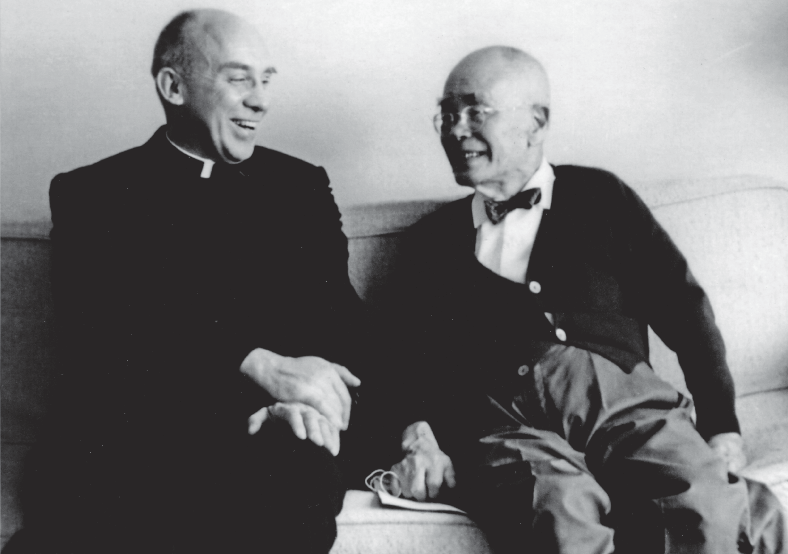
In early June 1964 Merton received a letter from D. T. Suzuki’s secretary telling him that, were he able to come to New York City a little later in the month, Dr. Suzuki would be extremely happy to meet him. Not long before, Merton had been examining the consequences—yet again—of the absolute travel restriction imposed on him. “As I go on,” he wrote in his journal, “the ways of escape are progressively closed, renounced, or otherwise abandoned. I know now that I am really committed to stability here, and that even the thought of temporary travel is useless and vain. I know that my contacts with others of like mind by mail, etc. are relatively meaningless, though they may have some raison d’être. I know that my writing solves nothing for me personally and that it has created some problems which are still unresolved…. That my position is definitively ambiguous and my job is to accept this with the smallest possible amount of bad faith.” Along this familiar path of thought, he had reached a familiar destination, though cloaked in darker light than usual: the resolve to accept his circumstances in the monastic spirit of obedience, with a minimum of what the Rule of St. Benedict, a document for the centuries, calls “murmuring.”
Some days after this journal entry, the letter arrived. “I thought about it,” he wrote, “and since it is probably the only chance I will ever have to speak to [Suzuki], I thought it important enough to ask Dom James’ permission. I certainly did not think he would give it, but, somewhat reluctantly, he did, and a flight is booked for me next Monday 15th.” What was Dom James thinking? Unknown. It seems very unlikely that he had time to consult with his superior, the abbot general; the decision must have been his own. He may have felt that a three-day trip to a reasonably nearby city to visit with a ninety-four-year-old sage, with agreed restrictions on Merton’s freedom to contact other people, might serve in the future as a model modest in all respects. What Merton said and what Dom James thought at this watershed moment is curiously undocumented, as if both men dropped out of their harrowing shared narrative, and the furious letter- and journal-writing that surrounds it, to try something else, something freer.
Instead of the explosive joy we might expect in Merton, the prospect of travel to New York caused him acute anxiety. His resource in the face of that anxiety was to immerse the opportunity in the sea of religion. “It was God’s will for me to ask, and for some reason I should go, not only for my own benefit. I am not supposed to understand, but have trust. There is more here than I know.” Replying promptly to Dr. Suzuki, Merton expressed his grateful acceptance of the invitation and alluded to the conditions set by his abbot: “I must ask you not to let this be too widely known…. It should not become generally known around New York as this would cause difficulties…. I hope to see you in the best of health and spirits.” Merton was to come and go with a sole focus. Living in a dormitory at Columbia University, his alma mater, saying Mass at the nearby church where he converted, eating in local restaurants many of which hadn’t changed since he knew them, he willingly accepted the anonymity James had asked of him.
It goes nearly without saying that as soon as he reached New York—even from the air as he approached—he was altogether happy; no further anxiety. The recognition we need here is that he met in Dr. Suzuki, at last, a living spiritual father—an abbot in all but name with whom he felt instinctively at home. Merton was once a Columbia graduate student exploring the poetry of William Blake, the nineteenth-century poet, graphic artist, and mystic. “Damn braces: Bless relaxes,” Blake had memorably written. The conversations of Merton and Suzuki were in that spirit. There are several homages to Suzuki in Merton’s writings, among them this:
One had to meet this man in order to fully appreciate him. He seemed to me to embody all the indefinable qualities of the “Superior Man” of the ancient Asian, Taoist, Confucian, and Buddhist traditions. Or rather in meeting him one seemed to meet that “True Man of No Title” that Chuang Tzu and the Zen Masters speak of. And of course this is the man one really wants to meet. Who else is there? In meeting Dr. Suzuki and drinking a cup of tea with him I felt I had met this one man. It was like finally arriving at one’s own home. A very happy experience, to say the least…. I did feel that I was speaking to someone who, in a tradition completely different from my own, had matured, had become complete, and had found his way.
“The tea, the joy,” he wrote in his journal after the first of two visits with Suzuki. One joy, “profoundly important to me,” was “to experience the fact that there really is a deep understanding between myself and this extraordinary and simple man.” Another was to feel so magically at home with him and with his secretary, Mihoko Okamura. “For once in a long time felt as if I had spent a moment in my own family.” Both experiences were crucial. In dialogue with Dr. Suzuki he could measure how far he had come through his years and struggles and strivings in the monastery—so much farther than he thought. A confirmation of this order would occur just once more, but few are needed: in conversation with the Dalai Lama in the fall of 1968. As for feeling profoundly at home with the ancient sage and his young companion, this too was a confirmation: that the orphaned child, the monastic misfit, remained undamaged. His heart was intact.
Excerpted with the publisher’s kind permission from Make Peace Before the Sun Goes Down: The Long Encounter of Thomas Merton and His Abbot, James Fox, Shambhala Publications, May 2015.♦
